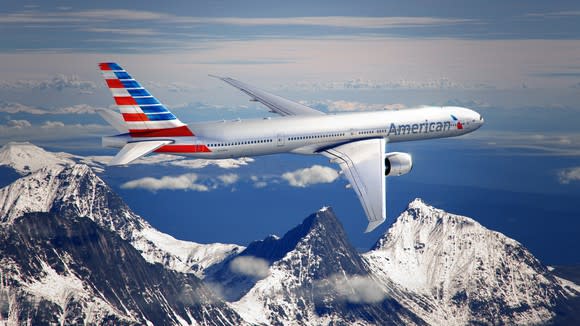Cost Creep Remains American Airlines' Achilles Heel
In recent years, United Continental's (NYSE: UAL) perennial margin deficit relative to Delta Air Lines (NYSE: DAL) has become a frequent topic of conversation among airline investors and analysts. By contrast, the growing margin gap between American Airlines (NASDAQ: AAL) and Delta has mostly flown beneath the radar.
At an investor day event last month, American Airlines' management laid out a blueprint for boosting earnings in the coming years. However, three years of big increases in non-fuel unit costs may have spoiled the company's chances of matching Delta's profit margin.
American's shining moment ends quickly
Just a few years ago, American Airlines seemed to be firing on all cylinders. Management's firm stance against fuel hedging paid off in a huge way as oil prices crashed beginning in 2014. The resulting fuel cost advantage allowed American Airlines to post a higher pre-tax margin than either Delta or United in 2015.

American Airlines outpaced its peers in terms of profitability in 2015. Image source: American Airlines.
However, American Airlines' adjusted pre-tax margin has quickly eroded since peaking at 15.3% in 2015. In 2016, a combination of declining unit revenue and rising non-fuel costs caused American's adjusted pre-tax margin to sink to 12.6%.
Unit revenue has returned to growth at American Airlines this year, but that hasn't been enough to offset the company's cost increases. In the first half of 2017, American's pre-tax margin fell by about 5 percentage points year over year, and the second half of the year isn't shaping up to be much better. American Airlines seems to be on track to post a full-year pre-tax margin of about 8%: right in line with United Continental and more than 5 percentage points behind Delta.
Non-fuel unit costs have skyrocketed
Cost synergies were never the rationale for the 2013 American Airlines-US Airways merger. From the beginning, management expected that most of the cost savings from the merger would be offset by well-deserved wage increases for the two carriers' employees. Instead, revenue synergies related to the combined carrier's expanded route network were expected to drive profit growth after the merger.
Still, investors clearly weren't prepared for the degree of cost inflation that American Airlines has experienced over the past three years. In 2015, non-fuel unit costs (excluding special items) rose 3.9% year over year, driven by wage increases for American's pilots and flight attendants. The company had also increased staffing during the year in order to ensure a smooth merger integration process.
Back in mid-2015, I predicted that non-fuel unit cost growth would recede in 2016. After all, American seemed to have an opportunity to reverse its 2014-2015 headcount increases. Plus, the carrier has been rapidly upgrading its fleet with newer, more cost-efficient jets. Finally, American Airlines has been adding seats to some of its jets in order to further reduce unit costs.
Boy, was I wrong. Cost inflation accelerated in 2016, as non-fuel unit costs rose 4.8% (again excluding special items). Based on American Airlines' first-half performance and projections for the rest of the year, unit costs will likely rise at an even faster clip in 2017.
Too little, too late
At the investor day last month, American Airlines CFO Derek Kerr said that cost creep would finally slow beginning in 2018. The company now expects adjusted non-fuel unit costs to rise about 2% next year, and roughly 1%-2% annually in 2019 and 2020.
This really isn't anything to get excited about. First, the guidance specifically excludes changes in labor costs. However, American Airlines' pilot contract becomes amendable in 2019, and while American just raised pilot wages significantly this year, it still remains behind Delta Air Lines in total pilot compensation.
Second, American Airlines is squeezing more seats than ever onto its jets to hold costs down. Most notably, American's 737 MAX planes will be configured with 172 seats, and the carrier will add 12 seats to each of its 737-800s to create the same configuration. The higher seating capacity and the reduction in legroom could hurt unit revenue growth for the next few years.
Third, even if long-term unit cost growth is 2% or less, American Airlines will need to post phenomenal unit revenue growth to reach its earnings targets (and catch up with Delta).
CEO Doug Parker seems to think that American Airlines can rely on unit revenue growth alone to fix its margin problems. You can count me as a skeptic. Unless American Airlines can find ways to become more efficient, it will probably join United Continental as a long-term laggard in the airline industry.
More From The Motley Fool
Why You're Smart to Buy Shopify Inc. (US) -- Despite Citron's Report
6 Years Later, 6 Charts That Show How Far Apple, Inc. Has Come Since Steve Jobs' Passing
NVIDIA Scores 2 Drone Wins -- Including the AI for an E-Commerce Giant's Delivery Drones
Adam Levine-Weinberg owns shares of Delta Air Lines. The Motley Fool has no position in any of the stocks mentioned. The Motley Fool has a disclosure policy.
